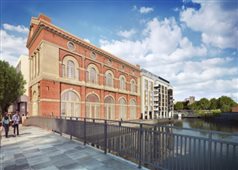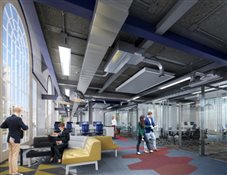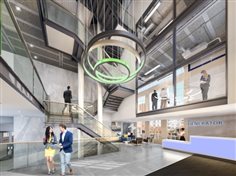Bristol’s iconic Generator Building – which powered the city’s tram system when it opened more than 100 years ago – could get a new lease of life as a base for tech, creative and media businesses.
The striking red brick and stone building overlooking the Floating Harbour has stood derelict for three decades but is set to be extensively renovated at the cost of £12m. 
Its limestone ashlar stonework and dramatic windows will be repaired and returned to their former glory with the transformation of its interior creating 28,300 sq ft of work space for up to 300 people.
The original 1890s arched front entrance on Counterslip with its grand Venetian window, which is currently sealed off, will be re-instated with new glass doors at street level.
These will open onto a double-height foyer, allowing visitors to enjoy the original scale of the internal spaces for the first time in 30 years.
The interior, which originally housed the massive generators for Bristol’s tram system, will contain five storeys of high-quality office space. The design, by Bristol architects Bush Consultancy, makes the most of the views across the harbour. Finishes will include exposed services and will complement the fabric of the building. 
The team behind the refurbishment say this will appeal to businesses in the burgeoning tech, creative and media sectors.
The driving forces behind the project are Bristol-based Cubex and its partner Palmer Capital – the developer and funder of the adjoining Finzels Reach scheme, which is transforming the city’s 4.7-acre former Courage Brewery site into one of the UK’s most ambitious city centre schemes.
Cubex director Gavin Bridge said: “We think this striking building is likely to attract companies from the creative, media or tech sectors who are looking for an inspirational environment in the heart of the city.
“This building has a fascinating history as the place that powered 20th century transport innovation, and it’s good to think it could become home to some of the companies at the forefront of today’s technology revolution.”
Bristol has an acute shortage of grade A offices, particularly the type favoured by its fast-growing tech and creative businesses – partly because many city centre office blocks have been converted for residential use and partly due to the reluctance of investors and developers to build offices without occupiers already lined up. 
The only speculative scheme in the city centre at present is Cubex’s 95,000 sq ft Aurora, next door to the Generator Building. The level of demand for high-quality creative space was demonstrated earlier this year when the nearby 25,000 sq ft Brew House, off Temple Way, became fully let after being converted to trendy loft-style workspace by London-based Verve Properties.
The Generator Building opened in 1899 to supply power to what was then the UK’s first electric tram system, which at the time was massively expanding.
Containing four steam engines coupled to four generators, it supplied power to the tramway system until 1941 when a bomb hit St Philips Bridge and cut the power cables.
Its architect William Curtis Green later became better known for designing the original Scotland Yard and the Dorchester Hotel in Park Lane, London. Bristol Civic Society has reviewed the current proposals and strongly supports the development, saying it will “make a major regeneration contribution” to the city.
Bush Consultancy has also been responsible for Finzels Reach’s new apartments in the Cask Store, Georges Wharf and Hawkins Lane as well as Castle Bridge, which links the development to Castle Park across the Floating Harbour.
Following a public consultation exercise, Cubex will submit a full planning application to Bristol City Council early next month. If it gains approval, work could start on the building next summer.






























